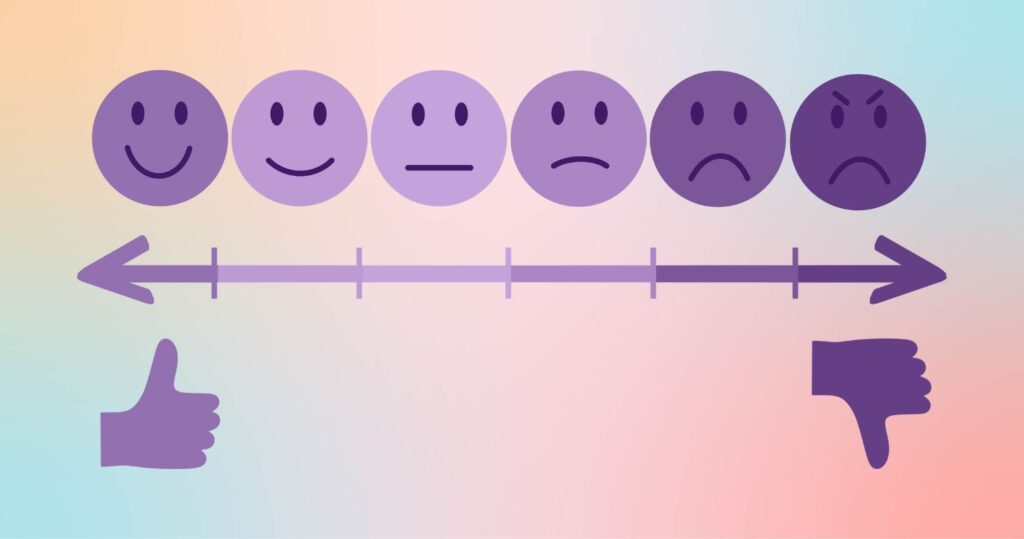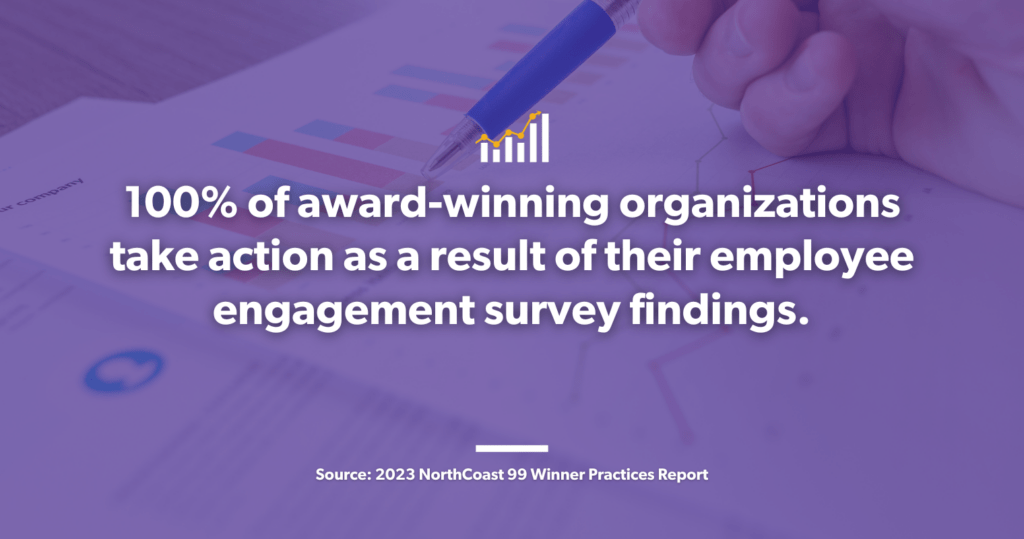
Not only are employee engagement surveys a common initiative that most organizations conduct these days, but they are necessary for any workplace that wants to achieve and retain a highly productive, competent, and motivated workforce.
These surveys are not just questionnaires. They are the bridge between an organization’s leadership team and their staff – a tool for developing a thriving company culture and a guide for overall organizational success.
Employee engagement surveys delve into the core of job satisfaction, uncover the drivers of employee commitment, and reveal the hidden potential within your teams.
What is an employee engagement survey? What are the features of a successful project? What should you communicate? How should you follow up on the results? In this comprehensive guide, we’ll explore the ins and outs of employee engagement surveys.
Understanding Employee Engagement Surveys
What Are Employee Engagement Surveys?
At their core, employee engagement surveys are a series of questions that employers use to gauge the level of engagement and satisfaction among their staff. These surveys are designed to measure various aspects of the employee experience, from daily operations to the overarching company culture. They serve as a confidential feedback mechanism, allowing employees to express their views on what’s working well and what needs improvement.
The Impact of Employee Engagement on Business Success
It’s no secret that engaged employees are critical to any successful business. Engaged workers are more productive, deliver higher-quality work, and are less likely to leave. .
But how does an organization increase employee engagement levels? The answer lies in understanding the direct link between how valued employees feel and how they perform. Employee engagement surveys are the key to unlocking these insights, providing actionable data that can lead to a more engaged workforce.
Designing Employee Engagement Surveys
Key Objectives of Employee Engagement Surveys
Before administering your survey, it’s essential to pinpoint exactly what you aim to achieve. Are you trying to reduce turnover, boost morale, or improve productivity? Perhaps you’re focused on enhancing company culture or identifying training needs. Whatever your goals, your survey questions should align with these objectives.
Some of the common themes and drivers of engagement that surveys aim to measure include:
- Employee experience
- Job satisfaction / Employee satisfaction levels
- Work-life balance
- Career development and professional growth opportunities
- Organizational culture
- Trust in senior leaders
- Relationships with direct managers
- Employee recognition and appreciation

Choosing Effective Survey Questions
The questions you ask in your survey can make or break its effectiveness. They should be clear, concise, and crafted to elicit honest responses. It’s a delicate balance between gathering the data you need and keeping the survey engaging and manageable for your employees. The questions should also be statistically validated with data.
At ERC, our survey model measures employee responses on a six-point, Likert scale spanning levels of agreement. Using a Likert scale in an employee survey is effective because it quantifies employee sentiment across a spectrum, allowing for nuanced survey responses.
This scaling method captures the intensity of employees’ feelings about specific statements, providing a clearer picture of their attitudes and opinions. By offering a range of options from strongly agree to strongly disagree, it helps organizations gauge the degrees of positivity or negativity in relation to workplace aspects, thereby enabling a more precise measurement of engagement levels.
Key Employee Engagement Themes to Consider
When choosing an effective survey, it’s essential to consider key themes that align with employee engagement. Consider the following:
- Engagement Indicators—Questions that assess an employee’s enthusiasm and dedication to their work and the company.
- Satisfaction Metrics—Key question types that determine employees’ contentment with their roles, work environment, and the organization’s policies.
- Feedback and Recognition—This effective type asks about the acknowledgment employees receive for their contributions and the feedback mechanisms in place.
- Development and Growth Opportunities—Questions that explore the support for career advancement and skill enhancement within the company.
- Work-Life Balance—Inquiries into how well the organization supports a healthy balance between professional responsibilities and personal life.
- Company Alignment and Advocacy—Questions that measure whether employees feel their values align with the company and if they would recommend the organization as a great place to work.
Pulse Surveys vs. Employee Engagement Surveys
Pulse surveys and more comprehensive employee engagement surveys serve distinct yet complementary roles in gauging employee sentiment.
Quick pulse surveys offer a rapid and streamlined approach, allowing organizations to frequently collect feedback and gain real-time insights into their team’s needs and experiences. These brief surveys are designed for ease and effectiveness, facilitating ongoing communication between employees and management.
On the other hand, employee engagement surveys provide a comprehensive analysis of engagement levels across various dimensions. They delve into the depth of employee sentiment, providing insights and in-depth metrics aimed at cultivating a deeply engaged workforce.

Implementing Employee Engagement Surveys
Best Practices for Survey Distribution
Timing is everything when it comes to survey distribution to ensure a high participation rate. Choose a period that’s free from other major company events or deadlines to ensure a better response rate. Communicate the purpose of the survey clearly and emphasize its confidentiality to encourage participation. Regularly remind and encourage your employees to complete the survey to maximize responses.
Survey Distribution Tips:
- Effective Communication—Start the survey process with clear messaging about the survey’s purpose, how it will be conducted, and its significance to the organization.
- Multi-Channel Distribution—Use a multi-channel approach for distributing the survey to reach employees through their preferred communication channels.
- Encourage Participation—Develop strategies to encourage survey participation, such as incentives or highlighting the importance of each individual’s feedback.
- Clear Instructions—Include clear instructions on how to complete the survey to reduce confusion and streamline the survey process.
- Deadline and Reminders—Set a clear deadline for survey completion and send out reminders to ensure a higher participation rate.
Encouraging Honest Feedback
The success of an employee engagement survey is heavily dependent on the honesty of the responses. To encourage candor, ensure anonymity and emphasize the survey’s role in driving positive change. Make it clear that all feedback, positive or negative, is welcome and necessary for improvement. When employees know and trust that an organization is employing an anonymous, third-party survey, feedback tends to be more honest and constructive.
Analyzing Survey Results
Once the results are in, the real work begins. Analyzing the data from your employee engagement surveys involves looking for trends, identifying areas of concern, and recognizing standout successes. It’s not just about the numbers; it’s about understanding the narratives behind them.
The insights from your surveys should inform your action plans. Whether it’s revamping your onboarding process, introducing new communication tools, or addressing workload management, the survey data should guide your decisions.
At ERC, our employee engagement consultants facilitate a review of the results with your leadership team. It’s important that we help you understand what the feedback means for your organization, not just deliver you a report with data.
Developing an Employee Engagement Action Plan
After the completion of an employee engagement survey, it’s important to develop a concise action plan that translates the collected data into tangible improvements. 100% of award-winning organizations take action as a result of their employee engagement survey findings. The action plan timeline should be clearly defined, with short-term and long-term goals that are both realistic and impactful.

Leaders should prioritize initiatives based on the survey results, setting clear objectives and assigning responsibility to ensure accountability. The key is to put this plan into motion soon after results are shared with the workforce. By maintaining that momentum, you demonstrate a commitment to your employees’ feedback and to fostering a culture of continuous development and satisfaction.
Common Challenges and Solutions
Overcoming Low Response Rates
A common hurdle with employee engagement surveys is ensuring that a significant percentage of your workforce participates. To combat low response rates, consider incentivizing participation with small rewards, making the survey available across multiple platforms, and providing ample time for completion. Regular communication about the importance of each employee’s voice can also drive higher engagement with the survey.
Addressing Negative Feedback
Receiving negative feedback in employee engagement survey results is a natural part of the process, and the silver lining is that it can be a goldmine for actionable insights.
Negative feedback, often coming from disengaged or dissatisfied employees, serves as a guide for the areas requiring urgent attention and improvement. It’s crucial to view these less-than-favorable responses not just as criticisms, but as constructive feedback that can drive significant and positive organizational change.
When addressing these concerns, it’s important to do so with an open mind, reflecting a genuine commitment to positive change and improvement. By sharing the findings with your workforce and clearly outlining the actionable steps your leadership team intends to take, you demonstrate transparency and a dedication to improving challenges and opportunities identified in your engagement survey.
Advanced Strategies for Employee Engagement Surveys
Segmenting Data for Deeper Insights
To get the most out of your survey data, consider segmenting the responses by department, role, tenure, or demographics. This can help you identify specific issues that may not be apparent in the overall data. For example, you might find that engagement is high overall but significantly lower in a particular department or among new employees.

Longitudinal Studies and Trend Analysis
Employee engagement is not a static metric—it evolves over time. Conducting surveys regularly and comparing the results can help you spot trends and measure the impact of any changes you’ve implemented. This longitudinal approach can provide a deeper understanding of the dynamics of employee engagement within your organization.
Conclusion: Key Takeaways for Your Employee Engagement Survey Strategy
In wrapping up our comprehensive guide, here are some key points to remember when conducting employee engagement surveys:
- Choose a Statistically Valid Tool – Ensure the questions in your employee engagement survey are reliable and statistically valid.
- Strategically Align Survey Content—Design your employee engagement survey with clear objectives that align with your company’s strategic goals, such as reducing turnover or enhancing culture, to gather focused insights for targeted action.
- Incorporate Regular Pulse Surveys—Consider integrating quick pulse surveys into your regular feedback mechanism to capture ongoing, real-time insights, complementing the deeper dive taken with comprehensive engagement surveys.
- Communicate Openly and Provide Clear Instructions—Be sure to effectively communicate the survey’s purpose and maintain transparency to boost trust and participation. Ensure that instructions for completing the survey are straightforward and that support is available for those who need it.
- Leverage Data for Organizational Growth—Analyze survey results to identify trends and areas needing attention. Use these insights to develop and implement specific, measurable actions that address the core concerns and opportunities highlighted by employees.
- Perform Segmented Analysis for Tailored Solutions—Segment the survey data for nuanced understanding and to identify department-specific or demographic-specific issues. Use these findings to create targeted interventions that address the unique needs of different groups within the organization.
Start Your Employee Engagement Survey Today
Now that you’re equipped with the knowledge and strategies for effective employee engagement surveys, it’s time to take action. Dive deeper into employee engagement surveys by visiting our Employee Engagement Survey page. For a personalized approach, speak directly with one of our employee engagement experts who can guide you through the next steps and set you on the path to a more engaged and productive team.
Frequently Asked Questions (FAQ’s)
What is the purpose of an employee engagement survey?
The primary purpose of an employee engagement survey is to assess the degree of engagement and satisfaction employees feel towards their workplace. It helps identify strengths and areas for improvement within the organization, providing insights that can lead to more effective management and a healthier workplace culture.
How often should a company conduct employee engagement surveys?
The frequency can vary depending on the company’s size, culture, and specific needs. However, an annual survey is common practice, with some companies opting for bi-annual or even quarterly pulse surveys to monitor engagement levels more regularly.
How do you choose the right method to administer employee engagement surveys?
Today, online surveys are often the go-to due to their ease of distribution and data collection. However, it’s important to consider your workforce’s preferences and accessibility. Consider the following:
- Access and Inclusivity—Consider employees that may not have internet or computer access or may not be comfortable using them.
- Anonymity and Privacy—Some employees may view paper surveys as more anonymous. It’s a company’s responsibility to choose a provider that ensures and protects employee anonymity when using online surveys.
- Distribution and Collection—Companies should consider the logistics of how they will distribute and collect surveys. Online surveys can be distributed instantly to employees’ emails, whereas paper surveys require physical distribution and collection.
- Data Analysis—Online surveys typically offer automated data analysis, which can save time and provide insights more quickly. Paper surveys, on the other hand, must be manually compiled and analyzed, which is more labor-intensive.
Whichever format you choose, ensure it’s user-friendly and accessible to all employees.
What makes a good employee engagement survey question?
A good survey question is clear, concise, and directly related to the aspects of engagement you wish to measure. It should be unbiased and structured in a way that allows for honest, thoughtful responses. The questions should also be statistically validated.
How can we ensure a high response rate to our employee engagement survey?
To ensure a high response rate, communicate the survey’s importance to the company’s success, guarantee anonymity, make it easily accessible, and consider providing incentives for completion. Regular reminders and a straightforward, user-friendly design can also encourage participation.
How do we handle sensitive feedback from employee engagement surveys?
Sensitive feedback should be handled with care and respect. It’s important to address the issues raised without violating the anonymity of the survey. Use the feedback as a constructive tool to make positive changes within the organization.
Can employee engagement surveys be anonymous?
Yes, and they often should be. Anonymity encourages more honest and candid responses, as employees feel safer sharing their true opinions without fear of repercussions.
What should we do after conducting an employee engagement survey?
After conducting a survey, analyze the data to identify trends and insights. Share the results with the management team and, where appropriate, with all employees, highlighting both positive findings and areas for improvement. Develop an action plan to address the feedback and follow up with employees on the progress made.
How long should an employee engagement survey be?
The length of the survey can vary, but it’s important to keep it as concise as possible while still gathering the necessary information. A survey that takes 10-15 minutes to complete is generally a good target to aim for, ensuring you respect employees’ time while capturing valuable insights.
Can we create our employee engagement survey, or should we use a professional service?
While many companies create their surveys, using a professional service or survey platform can provide statistical validity, a more robust framework, ensure anonymity, and help with the analysis of complex data. It can also lend credibility to the process and reassure employees that their responses are being handled professionally.
What are the next steps if our employee engagement survey reveals significant issues?
If your survey reveals significant issues, it’s crucial to address them promptly and transparently. Create a detailed action plan, involve employees in the solution where possible, and communicate the steps you will take to address the concerns. Follow through is key, as it demonstrates a commitment to your employees and can improve engagement over time.
